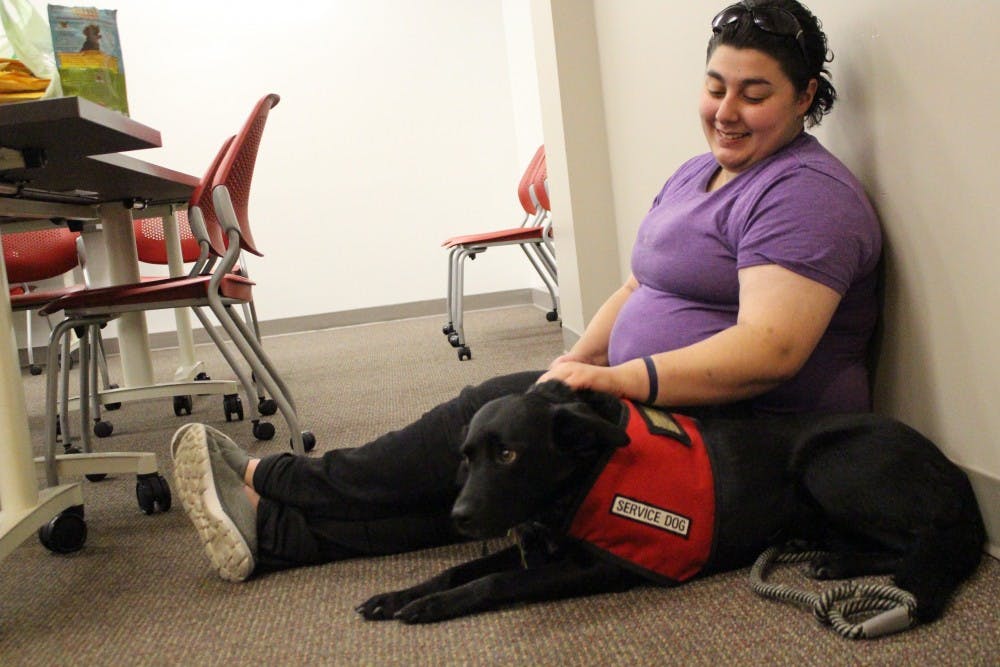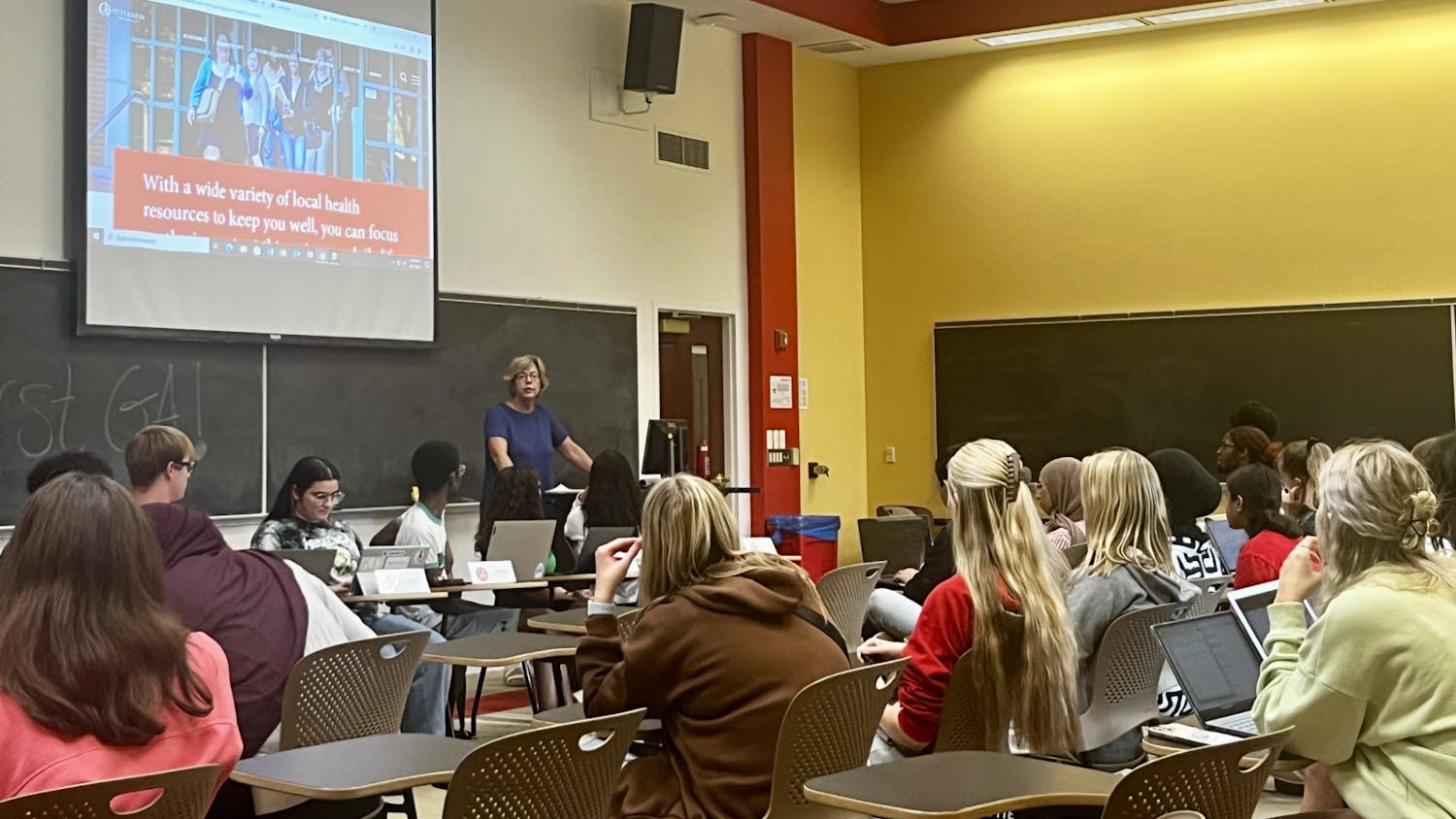We’ve all seen our furry friends around campus. Whether it be a trained service dog or one in training sitting in on a class, or an emotional support animal living in a dorm, these sightings seem to be a mutual experience shared by most, if not all Otterbein students. It’s simply too hard to be on Otterbein’s campus without coming across a dog or two.
Tracy Benner, director of residence life at Otterbein, says that under the Fair Housing Act, Otterbein is required by law to allow an assistance animal in residence halls if it will provide for a resident’s disability and help them enjoy residence life. To get one, students fill out a housing accommodation request form which can be found online or by contacting Benner. A written doctor’s note stating that the student has a disability or a need for an animal is required. Also, a veterinary note to show the animal is vaccinated, healthy and in no way a risk to other students and animals on campus.
Assistance animals can vary in meaning. There are emotional support animals (ESAs) and then there are service dogs. By definition, as stated in the Housing Accommodation Assistance Animal Policy for Otterbein, an emotional support (or assistance) animal’s sole function is to provide emotional support, comfort, therapy, companionship, therapeutic benefits, or to promote emotional well-being.
ESAs are not task trained for disability needs like a service dog. A service dog goes through hours of intensive training to perform tasks specific to their owner’s disability. ESAs only provide comfort. They’re also confined to the student’s assigned residence hall, whereas service dogs are allowed anywhere on and off campus where animals are usually not given access.
Though different, ESAs and service dogs have something in common: they have an impact on their two-legged companions, as well as the community at large.
Sophia & Benji

Sophia Bonsib and Benji have been together for three years now, and it’s easy to see that it’s a match made in heaven.
“He’s just been the best thing for me,” said Bonsib.
Freshman year was a big adjustment for Bonsib. Her anxiety and depression were at an all-time high and she didn’t want to take anymore medication. She lost sleep, had no motivation to get out of bed some mornings and cried a lot. The good times were overshadowed by the bad times, and Bonsib considered not coming back to Otterbein.
After doing some research, Bonsib decided that an emotional support animal would be her best option. She was used to her animals at home, and recognized that that would be the most therapeutic for her. So she rescued Benji, and the rest is history.
“It’s really nice to have someone else to worry about because it’s really helped me take the focus off myself,” said Bonsib.
Benji gave her a reason to get out of bed in the morning and brought her out of her shell. Bonsib says that the best part of her day is when she walks into her room and sees him and he’s so happy to see her. Even if Bonsib has a bad day, Benji always knows how to cheer her up.
Bonsib believes those considering getting an ESA or service animal need to be invested.
“This is not just something that ends after graduation,” said Bonsib. “Benji is apart of my life forever now.”
Kat & Lily Pad

Kat Fridenmaker and her kitten Lily just celebrated a milestone in their brief time together: Lily is officially on campus and living with Fridenmaker after her final vaccination as of mid-September.
As an RA for Devore Hall, Fridenmaker explains that having Lily helps keep her company since she doesn’t have a roommate. She also hopes that it will help build community between her and her residents.
“Just the thought of seeing Lily is something I really look forward to everyday. I can say, hey, sure this class is really rough right now but at least I can go see my kitten in a minute,” said Fridenmaker. Whenever she feels anxious, playing with Lily helps calm her down.
When talking about the process of approving Lily as an ESA, Fridenmaker described that there was some difficulty in filling out the paperwork. “It’s not super difficult, but I found it hard to put a mental illness on paper,” said Fridenmaker. She and her doctor spent a lot of time trying to figure that out. Luckily, her request fell through and Lily is officially home.
Fridenmaker has concerns about assumptions made about people with ESAs and service dogs. There is that underlying feeling of judgement, as if people think she is just bending the rules to have a pet on campus.
“There are a lot of people that are high functioning and may seem fine day-to-day, but you don’t know what’s going on inside their head,” said Fridenmaker. “Keep that in mind.”
Riley & Sadie

“The summer before my sophomore year my dad died of a massive heart attack next to me in a car,” said Riley Getz. “I had a lot of trauma that I had never dealt with, and everything came at once.”
Getz's grief counselor suggested that Getz would benefit from having an ESA, and that led to Getz meeting Sadie. They only met once and clicked immediately.
“She was happy, cuddly and wasn’t afraid,” said Getz.
Though Sadie was originally adopted as an ESA, Getz made an unexpected discovery over the winter. “She sensed my flashbacks, panic attacks and my disassociations and would immediately respond. She knew what to do without any training,” said Getz. From thereon, Getz decided to train Sadie to be a service dog.
Sadie is trained to perform several tasks for Getz specific to their trauma. These tasks can include keeping Getz grounded during flashbacks, waking Getz up from nightmares, and recognizing Getz's different triggers and alerting them.
Sadie is not a want for Getz, she is a need. “Because of all the trauma I went through, if I didn’t have Sadie to keep me safe and to help keep me in reality as much as possible, I wouldn’t be able to be at Otterbein. Without Sadie, it would be pointless,” said Getz.
Getz stresses that getting an ESA or a service dog is not a worst-case scenario. There is no invisible benchmark a student needs to reach to have one. It’s no less legitimate than any other avenue of help, and some things just work better for people than others. In Getz’s case, Sadie is what works best.
The next time students come across a dog in a vest, or an ESA in thie residence hall, they should know these animals have a purpose; they are not just a pet. They are someone’s support system and aide, and it’s important to recognize and respect that fact.






